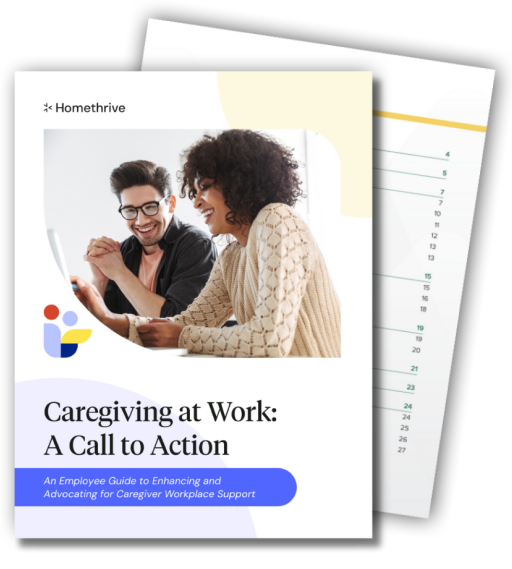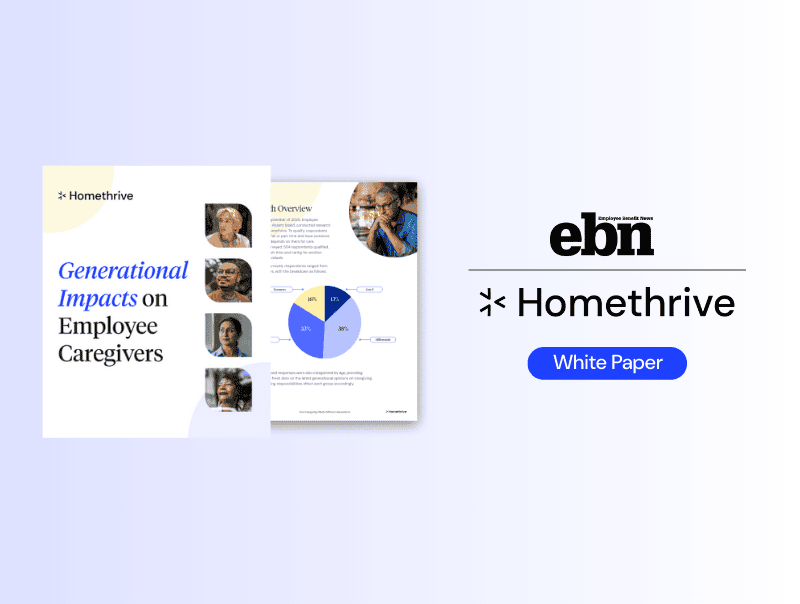Every November, organizations across the country observe National Family Caregivers Month. This month is dedicated to recognizing the millions who balance their careers with caring for a loved one. These individuals support aging parents, partners with chronic conditions, children with unique needs, or other family members who depend on them while managing multiple roles and responsibilities.
For many, caregiving is not a side role that happens after work. It is a second, unpaid job that runs in the background. The role affects the caretaker’s availability, energy, and work schedule.
The conversation around caregiving is no longer just a personal one. It has become an urgent workforce issue. Employers that understand and respond to the realities of caregiving build stronger, more resilient teams. Those failing to offer adequate support risk higher turnover, increased burnout, and lower engagement.
National Family Caregivers Month is more than a symbolic moment on the calendar. It is an opportunity for organizations to recognize caregivers and provide real support behind that recognition.
What National Family Caregivers Month Represents
National Family Caregiver Month honors the unpaid, essential work that family caregivers provide. While their contributions typically go unnoticed, their efforts are profound.
Family caregivers allow loved ones to remain in their homes longer, maintain their dignity, and avoid unnecessary hospitalizations or institutional care. They provide stability to families and communities. Yet they do so while managing their own jobs, financial responsibilities, and personal well-being.
Caregiving can take many forms. Some employees are providing light assistance, such as transportation or managing appointments. Others are delivering daily medical care, supporting someone through advanced illness, or coordinating multiple providers. Some are doing all of this while raising their own children.
The role is emotionally demanding and financially costly. Caregivers spend thousands of dollars annually to support their loved ones. They often reduce their hours or make career sacrifices to meet care responsibilities. These are not isolated experiences. They are part of the fabric of modern work.
For employers, National Family Caregivers Month is an invitation to look at these realities directly. It is a reminder that supporting caregivers is not just an act of goodwill. It is a practical way to help the people who make organizations run every day.
How Caregiving Impacts the Workplace
Caregiving responsibilities don’t pause when employees log on or walk through the door. They shape how people show up at work, how they structure their days, and what they can sustain over time.
Scheduling and Availability
Many caregivers start their day with responsibilities like medication management, personal care, or transportation. Others may end their day late into the night. As a result, rigid work hours can create unnecessary friction for people who are otherwise strong contributors. Flexible scheduling can reduce that strain.
Increases the Risk of Burnout
Caregivers often carry an invisible mental and emotional load that employers can’t see unless they look closely for the signs. Caretakers are less likely to have time to rest, recover, or attend to their own health.
Without adequate support, burnout symptoms can slowly creep into everyday functioning. Burnout doesn’t arrive instantly. It creeps in slowly through late nights, missed breaks, and the constant feeling of being behind. Other signs may include higher stress levels, increased absenteeism, and declining job engagement.
Impacts Retention Rates
With the additional expectations that come with caregiving, many employees find themselves scaling back on responsibilities, promotions, or advancement opportunities. In some cases, they leave the workforce entirely. When that happens, employers lose valuable knowledge and experience that can be difficult to replace.
Influences Organizational Culture
How a company responds to caregiving sends a strong message. Supportive policies and open communication create trust. A lack of understanding or rigid structures can leave employees feeling undervalued or forced to hide their reality. Over time, that erodes culture and weakens engagement.
Recognizing these impacts does not mean lowering performance expectations. It means creating environments where employees can meet those expectations more sustainably.
How Employers Can Respond Effectively
Addressing caregiving in the workplace doesn’t require an entirely new benefits strategy overnight. Small, focused steps can make a meaningful difference.
- Flexibility where possible. Adjusting schedules, meeting times, or hybrid work policies can give employees space to manage their responsibilities without sacrificing performance.
- Clear communication. When caregivers understand what options exist, they can make informed decisions and plan ahead. Ambiguity is often a bigger barrier than policy itself.
- Training for managers. Many employees first share caregiving responsibilities with their direct supervisors. Equipping managers to respond consistently, with empathy and clarity, reduces friction.
- Community building. Internal caregiver networks or Employee Resource Groups (ERGs) can provide peer connection, support, and advocacy for better solutions over time.
- Access to resources. Partnering with trusted organizations or sharing credible external tools can remove the burden of figuring everything out alone.
These practical measures don’t just help employees. They protect productivity, reduce preventable turnover, and strengthen culture.
Resources That Help Employers Support Caregivers
While individual resources help employees manage daily realities, employers also need strategic insight. These tools offer practical perspectives for leaders who want to build sustainable, scalable support structures.
The Case for Caregiving Benefits
This podcast episode explores the direct connection between caregiver support, retention, and workplace culture. It provides a clear business case for investing in solutions that meet real workforce needs.
Why EAPs Alone Can’t Provide the Support Your Employees Need
Employee Assistance Programs are often used as a catch-all for personal challenges, but they frequently don’t fully meet the complex, ongoing needs of caregivers. This article outlines where EAPs fall short and how layering additional support can make a real difference.
The Case for Care: Why Your Strategy Needs Caregiving Support
This guide lays out how caregiving intersects with retention, engagement, DEI initiatives, and overall organizational stability. It is a strong resource for HR leaders who need to build internal buy-in for expanding support.
The Hidden Cost of Caregiving: Retention, Productivity and Well-Being
In this panel conversation explores the real-world impact of rising costs and caregiving expenses on your employees’ well-being and job performance.
Employee Resource Groups give caregivers a place to connect, share experiences, and surface needs to leadership. This page offers guidance for creating or growing ERGs that center caregiver voices.
These tools are designed for employers ready to move from awareness to action.
Resources That Can Help Employees Who Are Caregivers
Many caregivers struggle to find reliable information or practical tools while juggling their responsibilities. The following Homethrive resources offer simple, actionable guidance to ease some of that weight.
What Type of Caregiver Are You?
Caregiving doesn’t necessarily mean what you think it does. This blog breaks down the different, possibly unexpected ways that we become caregivers by providing support for our loved ones.
Creating a safe home environment can reduce the risk of falls, injuries, and emergencies. This checklist walks caregivers through practical adjustments such as better lighting, secure walkways, and accessibility improvements. These small changes can help loved ones remain at home more safely and independently.
The Costly Consequences of No Estate Plan
Unfortunately, many individuals often postpone estate planning. For many, avoiding this step can ultimately lead to significant financial and emotional stress later. This podcast episode explores why having an estate plan matters and how caregivers can initiate these essential conversations before a crisis hits.
The Advantage of Senior Move Managers
Helping an aging parent or loved one move can be overwhelming. This podcast episode explains how senior move managers provide logistical and emotional support to make a major transition more manageable.
These resources are helpful starting points for employees navigating caregiving responsibilities, offering them clarity and relief in areas that can feel daunting.
Moving From Awareness to Action
Recognizing caregivers is important and supporting them is essential.
Many employees will not disclose their caregiving responsibilities unless they feel safe to do so. That means employer actions matter more than statements. When flexibility, resources, and support from leadership are consistent, employees see that caregiving is not something they need to hide.
The benefits of this approach extend far beyond individual employees. A supportive culture improves retention, strengthens engagement, and reduces turnover costs. It also fosters trust, encouraging employees to grow their careers within the organization.
A Call to Employers
National Family Caregivers Month is an opportunity to turn attention into momentum. Start with small, clear actions. Share resources. Review policies. Train managers. Open the door for honest conversations.
Caregiving is a workforce issue that will only grow in scale. Organizations that acknowledge it now will be better equipped to retain their best people, maintain strong performance, and build cultures that align with the realities of modern life.
By partnering with Homethrive, you can help employees reclaim valuable time and energy to focus on their work, families, and personal well-being.
Show your team they don’t have to choose between their careers and caregiving responsibilities. Contact us today to explore how Homethrive can enhance your employees’ well-being and productivity.







